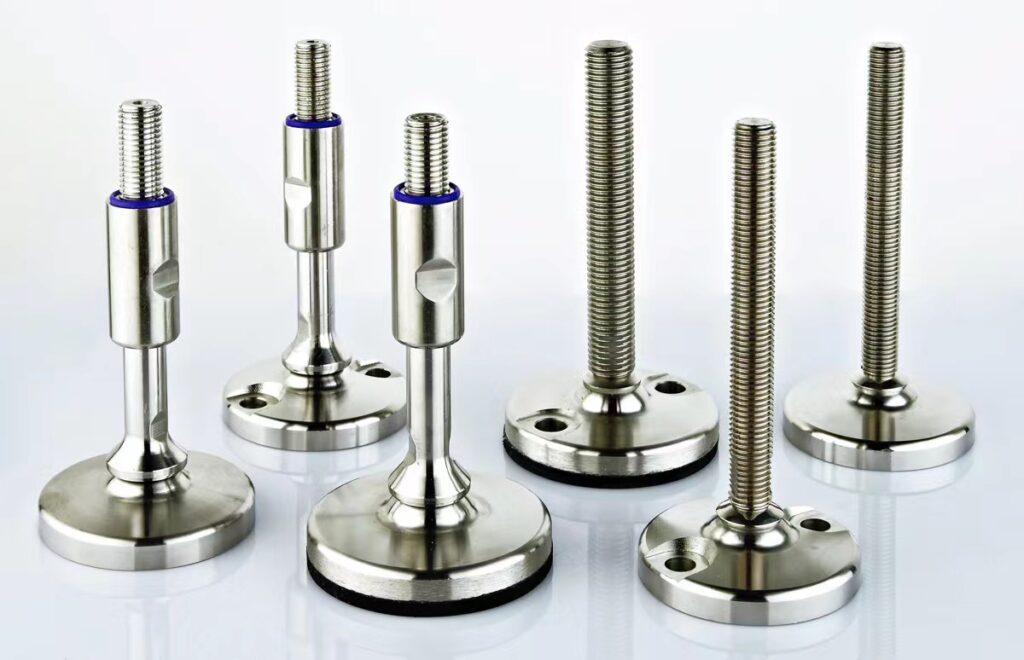The Essential Guide

In today’s industrial landscape, machinery plays a crucial role in various processes across numerous sectors. The performance and longevity of these machines are often influenced by factors beyond just their intrinsic mechanical and electrical components. One of these critical factors is the stability and vibration control of the machinery, which is where adjustable anti-vibration machine leveling feet come into play. This article explores the significance of these components, their features, benefits, and how they can enhance machine performance.
Understanding the Basics
What Are Adjustable Anti Vibration Machine Leveling Feet?
Adjustable anti-vibration machine leveling feet are specialized components designed to support and stabilize machinery while reducing the transmission of vibrations. These feet consist of a base plate that makes contact with the floor, a threaded shaft that allows height adjustments, and an anti-vibration pad that absorbs and dampens vibrations. By ensuring the machine is level and reducing vibrations, these feet help maintain optimal operating conditions.
Why Are They Important?
Machines that are not properly leveled can suffer from various operational issues, including uneven wear, increased noise, and decreased efficiency. Vibrations can cause misalignments, leading to potential damage over time. Adjustable anti-vibration machine leveling feet mitigate these risks by providing stability and dampening vibrations, enhancing the machine’s performance and extending its lifespan.
Key Features
1. Height Adjustability
One of the primary features of these leveling feet is their height adjustability. The threaded shaft allows operators to easily adjust the height to ensure the machine is perfectly level, regardless of the surface it sits on. This flexibility is crucial for machines installed on uneven floors or in environments where floor conditions may change over time.
2. Vibration Damping
The anti-vibration pad is a critical component that absorbs vibrations generated by the machine. This pad is typically made from materials like rubber or neoprene, which have excellent damping properties. By minimizing the transfer of vibrations to the surrounding environment, these pads reduce noise levels and prevent potential damage to both the machine and the building structure.
3. Load Capacity
Adjustable anti-vibration machine leveling feet are designed to support varying loads. It is essential to choose feet with the appropriate load capacity to match the weight of the machinery. Overloading the feet can compromise their effectiveness and lead to premature failure.
4. Corrosion Resistance
Many adjustable feet are manufactured with materials that resist corrosion, such as stainless steel or coated metals. This feature is particularly important in environments where the feet may be exposed to moisture or corrosive substances, ensuring long-lasting performance.
Benefits of Using Adjustable Anti Vibration Machine Leveling Feet
Enhanced Machine Performance
By ensuring the machine is level and stable, these leveling feet contribute to optimal machine performance. The reduction in vibrations helps maintain precision in operations, leading to better-quality outputs and reducing the likelihood of operational errors.
Extended Machinery Lifespan
Machines that operate with reduced vibrations experience less wear and tear on their components. This decreased strain extends the lifespan of the machinery, leading to cost savings in maintenance and replacement.
Improved Safety
Vibration and instability can pose safety risks in an industrial setting. By stabilizing machines, adjustable anti-vibration feet help create a safer working environment, reducing the likelihood of accidents caused by machine misalignment or unexpected movement.
Noise Reduction
Vibrations often lead to increased noise levels, which can be disruptive in a workplace. The damping properties of these leveling feet help minimize noise, contributing to a more comfortable and efficient working environment.
Versatility and Adaptability
These feet are suitable for a wide range of machines and industries, from small laboratory equipment to large industrial machinery. Their adaptability makes them an excellent investment for businesses with diverse machinery needs.
Selecting the Right Adjustable Anti Vibration Machine Leveling Feet
Assessing Your Needs
Before selecting leveling feet, it is crucial to assess the specific requirements of your machinery. Consider factors such as the machine’s weight, the floor conditions, and the level of vibration it generates. Understanding these parameters will guide you in choosing the appropriate leveling feet with the right load capacity and vibration-damping properties.
Material Considerations
Select materials that suit the environmental conditions in which the machine operates. For example, in wet or corrosive environments, stainless steel or other corrosion-resistant materials are advisable.
Professional Consultation
Consulting with professionals or manufacturers can provide valuable insights into the best solutions for your specific machinery and operational environment. They can recommend products that meet your needs and help ensure proper installation for maximum effectiveness.
Installation and Maintenance
Proper Installation
Correct installation is vital to ensure the effectiveness of adjustable anti-vibration machine leveling feet. Follow the manufacturer’s guidelines and consider professional installation if necessary. Ensuring that each foot is properly adjusted and the machine is level will maximize performance benefits.
Regular Maintenance
Routine maintenance checks can help ensure that the leveling feet continue to perform effectively. Inspect the feet for signs of wear or damage, and replace any components that show signs of failure. Regularly checking the level of the machine can also prevent potential operational issues.
Adjustable Anti Vibration Machine Leveling Feet: The Essential Guide
Adjustable anti-vibration machine leveling feet are essential components in maintaining the stability, efficiency, and safety of industrial machinery. By understanding their features, benefits, and selection criteria, businesses can enhance their operational performance and extend the lifespan of their equipment. Investing in high-quality leveling feet is a proactive step towards achieving optimal machine functionality and a safer working environment.
